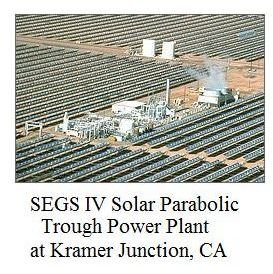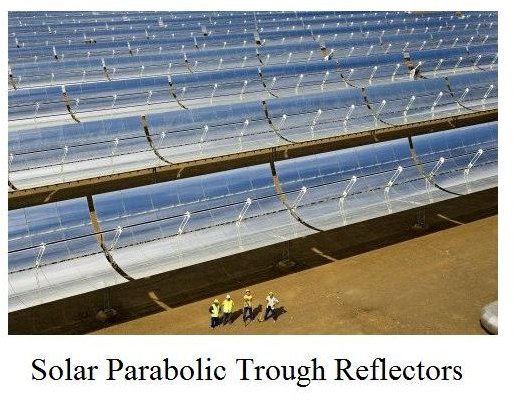The Solar Parabolic Trough Plant - The Most Commercially Available Concentrating Solar Power Technology
Introduction
A variety of concentrating solar power technologies have been under development to achieve higher fluid temperatures than flat plate collectors for some time, so that higher conversion efficiency can be obtained with a solar plant producing electricity from solar power. An introduction to the four leading concentrating solar power technologies is available in another article. The focus of this article will be on solar parabolic trough systems, which use a trough shaped parabolic mirror to focus incoming solar radiation on a fluid containing receiver tube.
General Description of a Solar Parabolic Trough Power Plant
The solar collecting unit used in a parabolic trough solar plant is single axis, tracking, trough shaped solar mirror. They focus incoming direct solar radiation onto a receiver tube located along the focal line of each

solar parabolic trough reflector. The picture at the left shows a close-up view of a field of solar parabolic trough reflectors. The picture at the right shows an aerial view of a solar parabolic trough power plant in California.
As described in the second article of this series, ‘Concentrating Solar Power Technologies 2: Parabolic Dish Stirling Engine Systems,’ only direct radiation, which travels in essentially a straight line from the sun to the earth, will be focused onto the receiver tube by a solar parabolic trough reflector. The diffuse component of solar radiation isn’t used by concentrating solar power systems such as this.
The fluid heated in the receiver tube is used to produce steam that is used in a Rankine cycle steam power plant to generate electricity.
Advantages and Disadvantages of the Solar Parabolic Trough Power System
Here are some advantages and disadvantages of a solar parabolic trough solar plant in comparison with the other three concentrating solar power technologies introduced in the first article of this series: heliotrope solar tower, solar parabolic dish - stirling engine, and linear Fresnel systems.
Advantages:
- Solar parabolic trough systems are the most developed and commercially tested concentrating solar power technology. Between 1985 and 1991, approximately 350 MW of solar parabolic trough power plants were put into operation in the Mojave Desert as SEGS (Solar Electric Generating System) I through IX. These 9 solar parabolic trough power plants have been generating solar electric power since then.
- Since solar parabolic trough systems produce steam to generate electricity with a conventional Rankine steam cycle, these systems can be readily hybridized, that is, they can be set up to use a fossil fuel (typically natural gas) as a supplementary fuel, so that electricity can be generated when the sun isn’t shining.
- The solar parabolic trough system is suitable for use in an Integrated Solar Combined Cycle System (ISCCS) with potential to reduce the cost and increase the overall solar to electric efficiency.
Disadvantages:
- The solar parabolic trough system doesn’t produce fluid temperature as high as some of the other concentrating solar power technologies, which makes its efficiency for electricity production lower.
Commercialization Status of the Solar Parabolic Trough Power System
As mentioned above, the solar parabolic trough system is the most commercially developed of the concentrating solar power technologies. The NREL link in the next section contains a list of over 40 solar parabolic trough power plants that are in operation, nearing completion, or are in planning around the world. Some of the SEGS solar parabolic trough plants in California have been operational for over 20 years.
References and Image Credits
Reference:
NREL, Concentrating Solar Power Projects, https://www.nrel.gov/csp/solarpaces/
Images:
Solar Parabolic Trough Reflectors: https://typesofsolarenergy.com/solar-power-plant.php
SEGS IV Power Plant: https://www.nrel.gov/csp/troughnet/power_plant_systems.html
About the Author
Dr. Harlan Bengtson is a registered professional engineer with 30 years of university teaching experience in engineering science and civil engineering. He holds a PhD in Chemical Engineering.
Related Reading
Comparison of Solar Chimney and Heliostat Solar Power Tower Systems - Two different types of power tower solar plant show great promise. One is the solar chimney power plant, that generates wind in a solar chimney to drive a turbine. In the other type, like Solar One and Solar Two, each heliostat in an array sends solar power to a central receiver on a tower.
This post is part of the series: Concentrating Solar Power Technologies
Concentrating solar technologies bring increased efficiency for solar power conversion to electricity in a solar power plant. The four current concentrating solar technologies are parabolic solar reflectors, heliostat solar power tower, parabolic dish - stirling engine, and linear fresnel systems.
- Concentrating Solar Power Technologies 1: Introduction to Alternatives
- Concentrating Solar Power Technologies 2: Parabolic Dish Stirling Engine Systems
- Concentrating Solar Power Technologies 3: Parabolic Trough Systems
- Concentrating Solar Power Technologies 4: The Heliostat Solar Tower
- Concentrating Solar Power Technologies 5: Linear Solar Fresnel Systems
